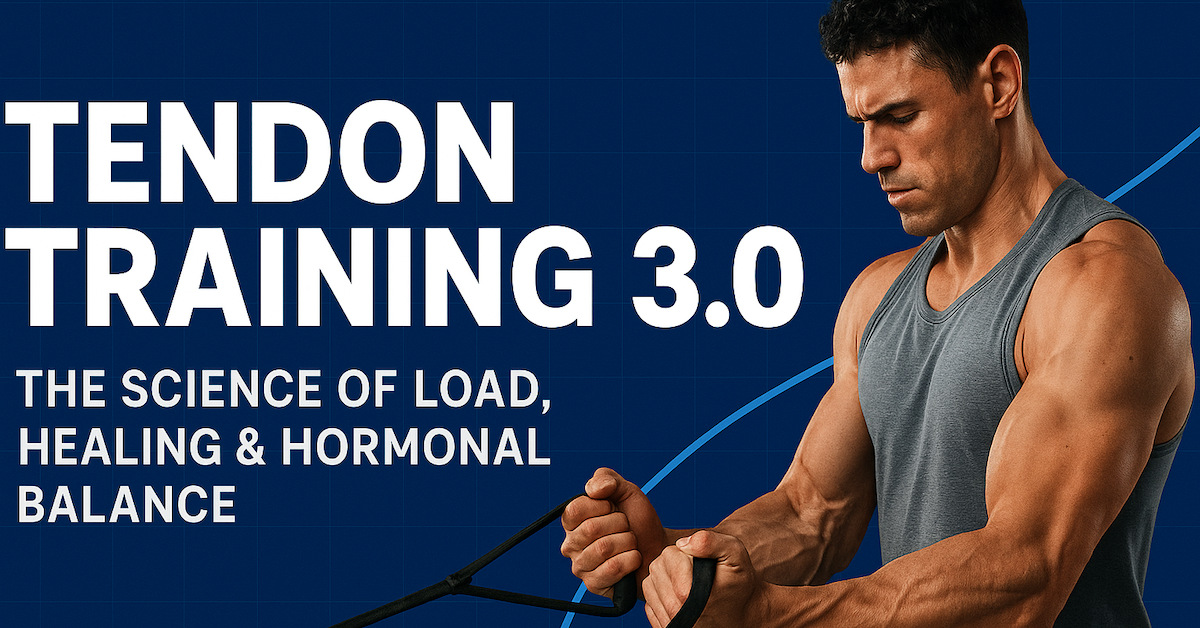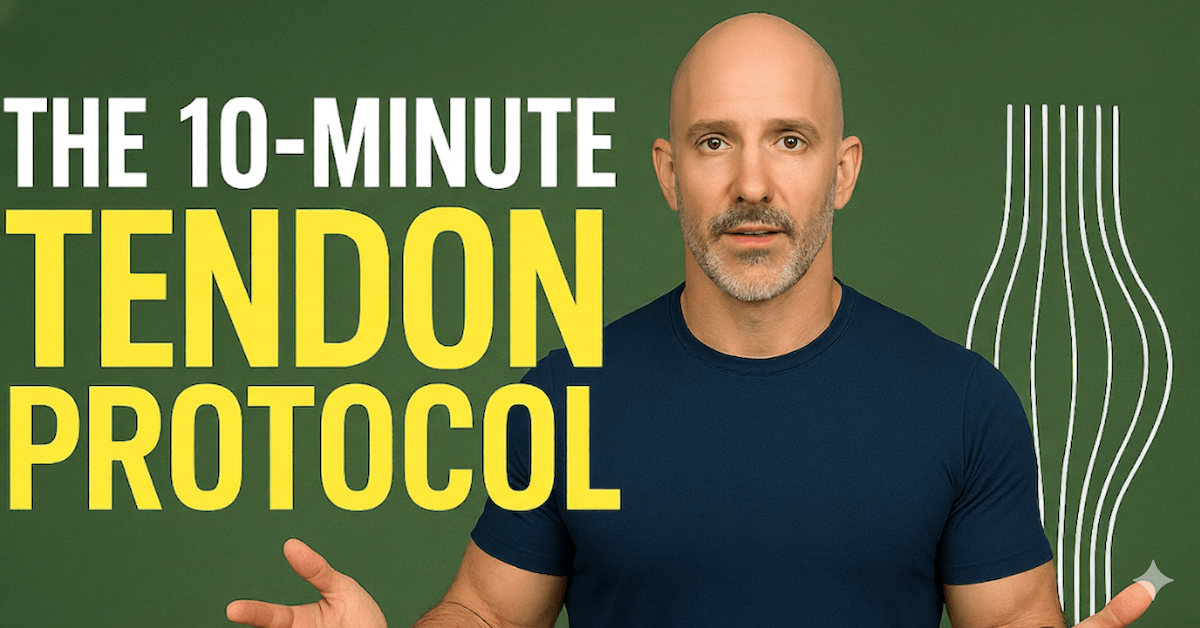If you haven’t read Part 1 — The 10-Minute Tendon Protocol: How to Build Stronger, Injury-Proof Tissue — start there first.
This follow-up dives deeper into Dr. Keith Baar’s most recent discussion on tendon injuries, rehabilitation, hormones, nutrition, and what truly drives connective tissue adaptation.
1. Rethinking Immobilization: Why “Boots” Do More Harm Than Good
Immobilization — using boots, braces, or slings — reduces mechanical stress on injured tissue, which might sound good but comes with a cost. Within three days, collagen breakdown begins, and scar tissue starts to form.
Without proper mechanical loading, tendons become weaker, not stronger.
Dr. Baar reminds us that immobilization dates back over 4,000 years, yet modern science clearly shows it delays recovery by blocking the signals tendons need to rebuild.
“If you take load off a tendon, you stop adaptation. The key is controlled stress — not total rest.”
2. Isometric Training: The Gold Standard for Tendon Repair
Tendons only need about 10 minutes of loading to trigger adaptation — anything beyond that causes wear and tear, not growth.
That’s why isometric training remains the foundation of tendon healing and resilience.
How It Works
- Isometrics (static holds) distribute tension evenly across strong and weak areas of the tendon, avoiding microtears.
- Eccentric training (slow lowering) isn’t magic — it works only because it slows movement.
The benefit isn’t “eccentric” loading; it’s low-velocity loading.
Protocol Highlights
- 4 × 30-second isometric holds
- Gradual ramp-up: 3 seconds to reach max comfortable force
- Rest 2 minutes between holds
- Pain ≤ 2/10
- Total session time: ≈10 minutes
- Rest 6–8 hours before repeating for optimal collagen synthesis
3. Overcoming vs. Yielding Isometrics
Overcoming Isometrics
Best for rehabilitation (e.g., tennis elbow).
Push against an immovable object — like a tennis racket wedged under a counter — and hold steady.
Gradually increase pressure for 3 seconds, hold for 30, then rest.
Yielding Isometrics
Hold a weight in position (e.g., holding a pan or dumbbell).
While beneficial later in rehab, this approach introduces jerk and overloading if not carefully controlled.
Start with overcoming isometrics before progressing to yielding versions.
4. The Role of “Jerk” in Tendon Injury
The biggest culprit behind most tendon ruptures isn’t heavy load — it’s jerk, the rapid change in acceleration.
A golf swing, tennis serve, or the bottom of a squat with bounce all create high jerk forces that exceed what tendons can handle.
Isometrics eliminate jerk entirely, allowing tendons to rebuild safely.
5. Hormones and Tendon Health
Hormones profoundly affect tendon stiffness, elasticity, and injury risk.
Estrogen
- Reduces collagen cross-linking, making tendons more compliant (stretchier)
- Can increase injury risk during the luteal phase (when estrogen is high)
- May have evolved as a childbirth adaptation
Testosterone
- Increases tendon stiffness but decreases collagen content
- Leads to more brittle tendons, especially in anabolic steroid users
Takeaway
Women may need more stability and slower eccentrics during high-estrogen phases, while men using testosterone should prioritize mobility and controlled isometrics to offset brittleness.
6. Inflammation, Recovery, and Ice Baths
Inflammation isn’t the enemy — it’s essential for adaptation.
Suppressing it with NSAIDs, high-dose antioxidants, or ice baths immediately post-training can blunt hypertrophy and tendon remodeling.
Smarter Recovery
- Use short, gentle isometrics (5 seconds) after injury — these squeeze fluid from tendons, reducing inflammation naturally.
- For general recovery, time your ice baths away from strength sessions (e.g., ice in the morning, lift in the afternoon).
- Combine ice bath recovery with protein and collagen intake later in the day for best results.
7. Nutrition for Stronger Tendons
Nutrition supports mechanical loading — not the other way around.
Dr. Baar emphasizes a “load first, feed second” strategy.
What to Use
- Collagen peptides (5–15g) + Vitamin C (~50mg) 30–60 minutes before tendon loading
- Combine with whey protein for leucine-driven mTOR activation
- Daily protein: 1.2–1.6g/kg bodyweight (roughly 4–5 servings of 20g protein)
8. Peptides, PRP, and Other Therapies
Many “biohacks” for tendon healing don’t hold up under scrutiny.
- BPC-157: No measurable effect on tendon or ligament cells.
Any perceived benefit likely comes from the injection trauma (“micro-pithing”) that reduces stress shielding. - PRP / Prolotherapy / Stem Cells: May help upper body tendons (e.g., rotator cuff) but provide little benefit in lower body injuries due to rapid load dispersion.
- JAK-STAT inhibitors: Promising in early studies for tendon repair but carry developmental risks in youth.
Bottom line: Load drives 95% of tendon adaptation. Everything else is marginal.
9. Early Loading After Surgery
Post-surgery, start gentle isometrics within 24–48 hours if cleared by your surgeon.
Even light tension prevents collagen loss and speeds recovery — often cutting rehab time by up to a month.
“Load it early, but load it smart.”
10. The Big Picture: Longevity Through Load
Tendon and ligament injuries are now the #1 musculoskeletal healthcare cost in North America, surpassing heart disease and diabetes combined.
Why? Because an injured person stops moving — and once you stop moving, everything declines.
The solution isn’t rest. It’s precision loading — short, controlled, consistent stimulus that keeps you strong, mobile, and independent for life.
Watch the Full Interview
Final Takeaway
Tendons don’t need more time — they need better timing.
Ten minutes of smart loading, twice a day, outperforms hours of exercise done wrong.
Train your connective tissue with intention and you’ll build strength, performance, and longevity that lasts.

Injury Prevention Strategies for Aging Athletes
As athletes age, the risk of injury grows—and recovery takes longer. Injury Prevention Strategies for Aging Athletes reveals proven methods to help you stay strong, resilient, and active for years to come. In this 60-minute webinar, John Paul Catanzaro shares practical tips you can use immediately to reduce injury risk both on the field and in the gym.

Tendon Training 3.0: The Science of Load, Healing, and Hormonal Balance
If you’ve followed our tendon training series so far, you know that Dr. Keith Baar’s research has reshaped how we

The 10-Minute Tendon Protocol: How to Build Stronger, Injury-Proof Tissue
Most athletes train muscles. The smart ones train tendons. The problem? Tendons don’t give you warning signs. There’s no such

Why METH Beats RICE for Injury Recovery: Science Finally Catches Up
Back in 2012, I introduced a controversial—but far more effective—approach to treating soft-tissue injuries. The acronym? METH, which stands for:
follow
Error: No feed with the ID 2 found.
Please go to the Instagram Feed settings page to create a feed.
